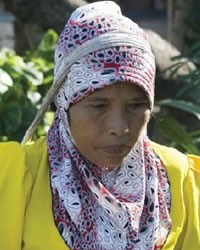Besemah in Indonesia

Photo Source:
Copyrighted © 2025
Anonymous All rights reserved. Used with permission |
Send Joshua Project a map of this people group.
|
| People Name: | Besemah |
| Country: | Indonesia |
| 10/40 Window: | Yes |
| Population: | 764,000 |
| World Population: | 764,000 |
| Primary Language: | Malay, Central |
| Primary Religion: | Islam |
| Christian Adherents: | 1.50 % |
| Evangelicals: | 0.01 % |
| Scripture: | New Testament |
| Ministry Resources: | Yes |
| Jesus Film: | Yes |
| Audio Recordings: | Yes |
| People Cluster: | Pasemah of Sumatra |
| Affinity Bloc: | Malay Peoples |
| Progress Level: |
|
Introduction / History
The Besemah territory surrounds a volcanic peak, Mount Dempo. Besemah communities spread from that volcano's slopes to the west, south and southwest along the Bukit Barisan Mountain range. Historically, their political center was Pagar Alam, which helped protect the Besemah from their aggressive neighbors, mostly the Rejang. The Besemah live in South Sumatra province across a few districts in the Lahat regency and the entire Pagar Alam municipality. Some Besemah also live in the South Ogan Komering Ulu (OKU) regency and in North Kaur district.
What Are Their Lives Like?
The Besemah make a living in farming centered around three key crops: rice, rubber and coffee. Groups of 5-10 people working in a wage or crop sharing system carry out the planting and harvesting.
The Besemah build their houses Besemah houses on raised platforms as high as 1.5-2.5 meters off the ground. Their houses are built from wood, with tin roofs and usually have three to four rooms including a closed kitchen in the back part of the house. They use the area under the house for various purposes, such as a place to cool down on hot days, or a place to store tools, food and other items.
The Besemah recognize three types of marriage: (1) belaki, where groom pays a bride price, pays for the wedding and the newlyweds live with the husband's family; (2) ambil anak, in which the husband moves in with the wife's family and does not need to pay for anything, neither the bride price nor for the wedding; (3) semendean, in which the wedding cost is split and the newlywed couple are free to choose where to live. These days, many youths follow yet another pattern for marriage, eloping.
What Are Their Beliefs?
For the most part, the Besemah follow Sufi Islam. Islam entered the southeastern part of the Besemah area in the 16th century. The west and northwest areas converted to Islam in the 19th century. Sufi Islam focuses on feelings and stresses the importance of knowing God more than merely observing religious rituals.
The Besemah also practice elements of Buddhism and animism. The Besemah highlands include 26 historical sites including ruins, cemeteries and domes enclosing statues of Buddha that have been considered sacred places since the 2nd century. Large stone statues depict such scenes as a soldier riding an elephant, a man wrestling with a snake and a large ocean wave. Besemah people still use these statues as sites for making sacred oaths and calling upon their ancestors' spirits for blessing and seeking their protection against natural disasters.
What Are Their Needs?
The Besemah people need better medical care. They also need help and training to increase crop production through use of appropriate technology for packaging coffee for sale. Wise development of the coffee industry could greatly benefit the Besemah.
The New Testament is available in the Central Malay language spoken by the Besemah, as are the JESUS Film and other Christian resources.
Prayer Points
Thank God for the availability of the New Testament and the JESUS Film in the Central Malay language; pray for distribution of the scriptures and opportunities to show the JESUS Film.
Ask the Holy Spirit to give Besemah leaders a spiritual hunger that will lead them to seek and find the only savior.
Ask God to send the Besemah gospel workers who can help with their needs for medical care and agricultural training, along with sharing the gospel.
Pray for a Disciple Making Movement among the Besemah people.